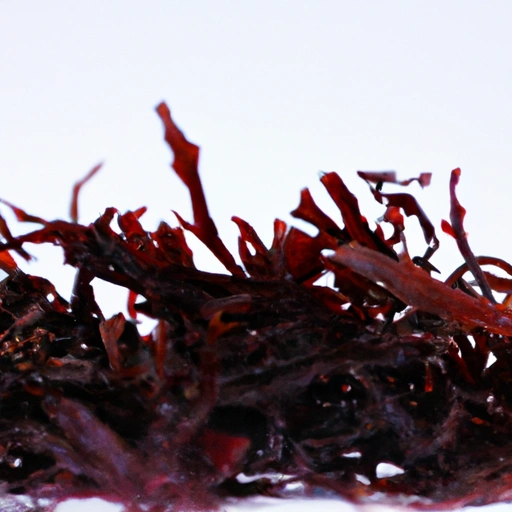Dulse
Description

Dulse, also known as Palmaria palmata, is a red seaweed that grows wild in the cool waters on the northern coasts of the Atlantic and Pacific Oceans. This marine vegetable is prized for its unique taste and nutritional properties. It is commonly used dried or fresh in a myriad of culinary applications, and can be a splendid source of minerals and vitamins for vegetarians, vegans, and health-conscious individuals alike.
Common uses
Dulse is traditionally used as a snack food, in soups, stews, and salads, or as a flavor enhancer in various dishes. It is also popular as a health supplement, given its impressive nutritional profile.
Nutritional value
Calories
A 1/4 cup (7g) serving of dulse provides approximately 18 calories (75 kJ).
Protein
The same serving size contains about 2 grams (0.07 oz) of protein.
Fat
Dulse is low in fat, with a serving containing less than 1 gram (0.035 oz).
Carbohydrates
Carbohydrates amount to approximately 3 grams (0.1 oz) per serving.
Vitamins
This seaweed is rich in vitamins, particularly B6 and B12, and a good source of vitamins A and C as well.
Minerals
Dulse is an excellent source of minerals, especially iodine, potassium, iron, and magnesium.
Health benefits
With its high content of vitamins, minerals, and antioxidants, dulse is known to support thyroid function due to its iodine content, improve circulation, boost the immune system, and promote digestive health. It's also believed to have benefits for skin health and may contribute to lower blood pressure and improved bone health.
Potential risks
Although dulse is nutritious, overconsumption can lead to excessive iodine intake which may affect thyroid function. It's important to consume dulse in moderation, especially for those with thyroid conditions. Some individuals may also experience allergies to seaweeds such as dulse.
Common recipes
Dulse can be used to add a salty, umami flavor to soups, chowders, sandwiches, and salads. It is also used to make dulse butter or to season dishes as a healthier alternative to salt.
Cooking methods
This seaweed can be eaten raw, pan-fried until crispy, baked, or boiled in soups and stews.
Pairing with other ingredients
Dulse pairs well with ingredients like potatoes, eggs, tofu, and grains, as well as a wide variety of fish and shellfish, complementing their flavors and adding a nutritious boost.
Summary
Dulse is a versatile and nutrient-dense seaweed with a long history of culinary use in various cultures. It offers a range of health benefits, but should be consumed in moderation due to its high iodine content. From enhancing the flavor of dishes to providing a wealth of nutrients, dulse is an ingredient worth exploring in the kitchen.